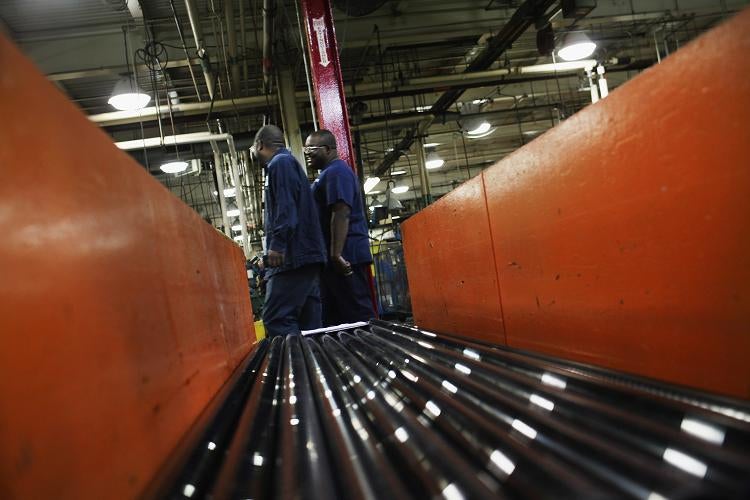American exporters are doing better than many think

Your support helps us to tell the story
From reproductive rights to climate change to Big Tech, The Independent is on the ground when the story is developing. Whether it's investigating the financials of Elon Musk's pro-Trump PAC or producing our latest documentary, 'The A Word', which shines a light on the American women fighting for reproductive rights, we know how important it is to parse out the facts from the messaging.
At such a critical moment in US history, we need reporters on the ground. Your donation allows us to keep sending journalists to speak to both sides of the story.
The Independent is trusted by Americans across the entire political spectrum. And unlike many other quality news outlets, we choose not to lock Americans out of our reporting and analysis with paywalls. We believe quality journalism should be available to everyone, paid for by those who can afford it.
Your support makes all the difference.The United States isn't making things that the world wants to buy.
That is an all-too-common sentiment, a kind of fatalist view of America's place in the modern global economy. The shred of truth in it is the fact that the nation has maintained large and persistent trade deficits with the rest of the world for the past two decades or so, with little end in sight.
The latest numbers from the Commerce Department would seem, at first glance, to confirm that gloomy assessment. The trade deficit widened in August to $44 billion, from a revised $42.5 billion in July, as imports were little changed and exports fell 1 percent. The recent trends for exports have indeed been weak. But they mask some more promising signs.
American exporters are reasonably successful on the global stage, selling overseas everything from soybeans to jet aircraft, banking services to Disneyland vacations. Last year, U.S. exports totaled $2.1 trillion, a 14 percent rise from 2010. That activity accounted for many millions of jobs and about 14 percent of the nation's economic output.
If the world economy is going to come into better balance, with fewer vast sums of money sloshing around the globe fueling bubbles like the ones that imploded disastrously in 2008, it will be in part by getting that number up over time, and there has been progress. For the first eight months of the year as a whole, there was meaningful progress. That slowed in the summer, and the question is how lasting the downturn will be.
Looking at the inner details of the latest export numbers — what American goods and services are being bought internationally and where — gives a sense of both optimism at the nation's often understated advantages, and reasons to worry about the near-term.
Strong growth is evident in a number of categories of exports, particularly of sophisticated, complicated manufactured goods. Civilian aircraft exports are up 38 percent in the first eight months of 2012; telecommunications equipment up 7 percent; drilling and oilfield equipment up 24 percent; agricultural equipment up 23 percent; pharmaceuticals up 7 percent. Some of the big losers among U.S. exports appear to be one-time problems tied to the drought in the American heartland: Wheat exports were down 34 percent and corn exports down 22 percent.
There was solid progress in that time span in exports to China, America's longstanding frenemy in economic relations. Through the first eight months of the year, exports to China were up 5.9 percent, which is roughly as fast as that nation's economy appears to be growing. In other words, Chinese purchases of American-made goods and services is growing, though not relative to its overall economy.
But all these trends look better over the January-through-August period than they do when looking more narrowly at the last few months. August to August, growth in exports to China was only 2.2 percent. Indeed, as the country tries to pivot toward a more consumer-oriented economy and away from investment, its demand for the heavy equipment that America makes to pave roads and build factories could come under further pressure.
And the same is true of the euro zone and its depressed economy. Over the first eight months of the year, U.S. exports to the 17 E.U. nations using the euro currency was up 1.2 percent. August to August, it was down 3.5 percent, reflecting both a European economy that has slowed as the year has progressed and a drop in the euro against the dollar that made U.S.-manufactured goods less competitive.
The result of those slowdowns in China and Europe is a slump in demand for some of the very products that the United States excels at making. Civilian aircraft, for example, after rising at a 38 percent rate through the first eight months of the year, was up only 1.1 percent in August compared to July. Pharmaceutical exports actually turned negative, falling 11 percent in August alone.
The question for U.S. exports — and the global rebalancing overall — is whether the downturns in China and Europe will be short lived enough that the longer, more optimistic trend can take hold once again.
Join our commenting forum
Join thought-provoking conversations, follow other Independent readers and see their replies
Comments